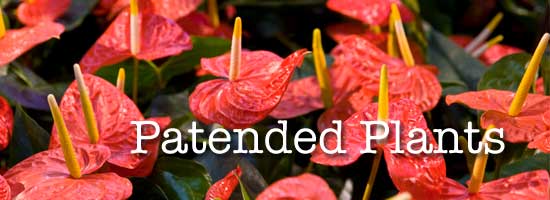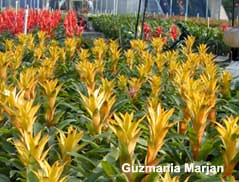
Have you ever bought a plant which had a tag saying it was patented plant, which had a tag that read – "asexual reproduction prohibited."
What does that mean exactly?
Is this plant variety superior or better than others?
Many people when buying a plant believe… a plant is a plant is a plant. One variety is no better or different than another. They all grow the same. For many years lots of growers felt the same way.
In recent years many new varieties of indoor and outdoor plants have been introduced. In the 1970’s we saw the introduction of a few new Aglaonemas. The 1980’s brought us new Spathiphyllums and many new Anthuriums. Throughout the 1990’s to present we’ve seen new varieties in just about all of the major plant groups produced.
To name just a few:
- Anthurium
- Aglaonema
- Bromeliad
- Dracaena
- Orchid
- Philodendron
- Spathiphyllum
- Ficus
- Schefflera
Some of the varieties carry different names, some come with trademarks and others hold plant patents. Whatever they call themselves a few questions need to be asked – such as:
What makes a “named” or patented plant variety better?
- Is it really better?
- Can these plants make my plant care easier and more enjoyable?
- Do they cost more?
- How can I identify these new varieties?
- How can I find these new plants?
What makes a “named” Variety Better? Are They Really Better?

Let’s handle the first two questions together. Just because the plant carries a unique name this doesn’t make the plant better. What purpose it does serve – it helps identify the plant and assist you in your plant selection and care.
Most of the new “named” varieties are patented, trademarked or are in the process of being patented. This helps since most of these plants have gone through trials and testing before investing in the cost of patenting the plant.
Don’t cross off a plant because it does not carry a plant patent. There are many beautiful bromeliads and orchids and great indoor/outdoor performers but do not carry patents. The patent gives you “just another check mark” to help you make a plant buying selection.
Can these plants make my plant care easier and more enjoyable?
There are many benefits in purchasing these “named plant varieties”. First you’ll find a “tested” plant.

Testing goes about in a couple of ways. One or a group of growers may grow the plant to see how well it does when grown in a production setting. It’s surprising how many plants do very well inside a home but the grower may face problems in the greenhouse. The plant just doesn’t grow well under greenhouse conditions. Such is the case with Aglaonema “Silver Frost”.
Another form of “testing” is with the interior plantscaper. New varieties allow them to offer clients different looks – but these new plants must also be able to adapt and handle the plant maintenance schedules the plantscaper uses. Also, interior technicians will not need additional training on each new plant introduced.
Ultimate Plant Testing
The ultimate form of testing any houseplant or outdoor variety comes from the market. It boils down to the simple fact – will the market try the plant and if the market likes it.
More Plant Benefits
Another benefit these named and selected varieties give – much more predictable. You should be able to know the height and width the plant will reach. This helps you know “what space” you’ll need for the plant and container… today and in the future. With a generic variety or species there can be wide variations.
Plant “traits” are selected for:
- Height
- Leaf color
- Leaf shape
- Flower color
- Time of flowering
- Quantity of flowers
- Cold tolerance
- Size
- Market needs
- Disease resistance
- Wider range of acceptable growing and care extremes.
For instance, many of the new Aglaonema hybrids can handle much cooler temperatures. Spathiphyllums are grown in small pots with lots of flowers. The weeping fig Ficus dropping leaves, can be trained as table top decorations or have new growth that is reddish.
When you find “the named” plant perfect for your lifestyle or design needs, these selected plants give you an opportunity to purchase the exact same plant again, since it’s heritage is the same.
If you are looking to meet a certain care, light or space requirement you’re almost certain to find it with so many new plants to choose from. The end result? It adds up to a better plant requiring less care and more enjoyment.
Do Patented Varieties Cost More?
Sometimes these plants do cost more. Growers must pay royalties on these new plants especially patented varieties and the cuttings generally cost more. But the cost is usually minimal compared to the better quality and known characteristics of the plants you’ll start with.
How can I identify these new varieties?
Look for the tags. You’ll usually find them attached to the branch or stuck in the pot. Breeders and hybridizers spend hundreds of hours, and tens of thousands of dollars developing new varieties. They want you to know what you’re buying.
Look for the complete name like Aglaonema ‘Royal Ripple’ PAT #9070 or Spathiphyllum ‘Sweet Pablo’ PAT #10817
How can I find these new plants?
To learn about these new plants visit our site – regularly as we’re always expanding the information available and looking to introduce new varieties.
Ask your local garden center or nursery. They have the ability order these new varieties from their plant supplier but many times “don’t want to take a chance”. You need to give them specifics. What plant by name. Use botanical names whenever possible!
Let’s address the plant propagation question.
When a plant receives a patent the law states:
“The grant, which lasts for 20 years from the date of filing the application, protects the inventor’s right to exclude others from asexually reproducing, selling, or using the plant so reproduced.”
What this means is that you cannot purchase the plant, propagate the plant and then sell the plant. You have the right to grow the plant you purchased but not cut it up and start new ones.
Although these “new plant varieties” offer many advantages for long term plants they do not guarantee success. Starting with a good quality plant and learning more about the plant is the beginning of Plant Care success.


{ 2 comments… read them below or add one }
Now I’ve Really heard it all..
A patent holder can tell me what Not to do with a purchased plant?
That’s like Burger King telling me what Not to do with a Whopper!
Maxwell House telling me “Do Not add water, brew, or enjoy.”
When I purchase a plant, it’s now mine. I own it. (Some of them own me!)
If I want to root some cuttings for my own use, or to give away for someone else’s enjoyment, that’s exactly what I’m going to do!
What’s Next? The Plant Police?
I understand where you are coming from… but they do not want people propagating and then selling the plant.
You must log in to post a comment.